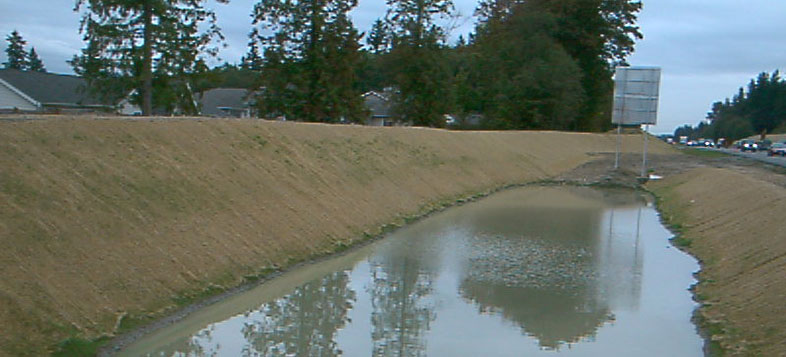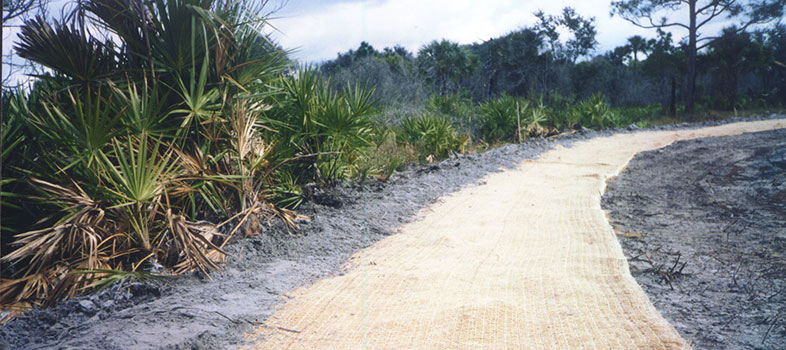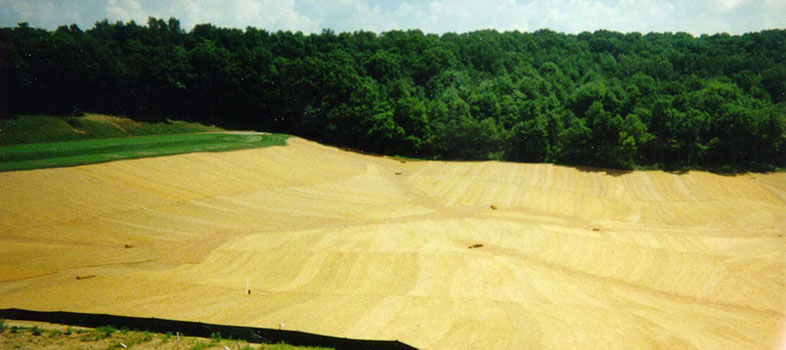North American Green Temporary Erosion Control Blankets
North American Green’s photodegradable erosion control blankets are designed to provide immediate erosion protection and vegetation establishment assistance, then degrade after the root and stem systems of the vegetation are mature enough to permanently stabilize the underlying soil.
Short-term photodegradable erosion control blankets are designed to provide erosion protection and promote vegetation establishment for 45 days up to 12 months, depending on the product. These blankets consist of an evenly distributed layer of 100% agricultural straw stitched to a single or double-netting structure with degradable thread. Short-term blankets are designed for moderately sloping areas and low-flow channels, where bare-ground seeding and loose mulches often fail. After the blankets degrade, soil erosion is controlled by the root, stem, and leaf structures of the mature vegetation.
Extended-term and long-term photodegradable erosion control blankets utilize a double-netting structure and a long-lasting, coconut-fiber component to provide erosion protection and assist vegetation establishment for 18 to 36 months, depending on the product. These blankets are designed for immediate to long-term erosion protection and vegetation establishment on steep slopes, medium to high-flow channels, and shorelines. After the blankets degrade, soil erosion is controlled by the mature vegetation’s root, stem, and leaf structures.
When minimizing environmental impact and ensuring wildlife safety are vital factors in a soil stabilization, erosion control, or sediment control project, the use of biodegradable erosion control blankets is a necessity. The number of public and private entities requiring the use of 100% biodegradable products increases each year, because of prior problems caused in large part by non-biodegradable netting.
- Geotextiles
- TenCate Mirafi Geotextiles N-Series & X-Series
- TenCate Mirafi Geotextiles S-Series
- TenCate Mirafi Geotextiles FW-Series
- TenCate Mirafi Geotextiles HP-Series & PET-Series
- TenCate Mirafi Geotextiles RSi-Series & H2Ri-Series
- TenCate Mirafi Geosynthetics MPV, MPG (PGM-G), and MPG4 (PGM-G4) Paving Fabrics
- Sediment Control & Construction Site BMPs
- Silt Fence
- Straw Wattles
- Floating & Staked Turbidity Barriers
- Applied Polymer Systems Polyacrylamides (PAM)
- Applied Polymer Systems Floc Logs
- Link Manifold System
- Floc Pit System
- Hach Portable Turbidimeter
- Dewatering Bags
- Curb Inlet Protection
- Drop Inlet Protection
- Sand, Sand-Cement & Rock Bags
- Rattle Grate Trackout Control
- FODS Trackout Control Mat
- Outpak Universal Portable Washout
- Erosion Control
- Hydroseeding Mulches
- North American Green Biodegradable Blankets
- North American Green Temporary Erosion Control Blankets
- North American Green Permanent Turf Reinforcement Mattings
- InstaTurf High Performance Erosion Control Mats
- Presto Geosystems Perforated GEOWEB
- Flexamat Concrete Mat Systems
- ARMORFORM Fabric-Formed Concrete Revetment Systems
- Maccaferri Reno Mattresses
- Tencate Geotubes for Shoreline Protection
- Geotextile Tubes for Lake Embankment
- Silt Fence
- Bioengineering Solutions
- Subgrade Stabilization & Load Support
- TenCate Mirafi Geotextiles RSi-Series & H2Ri-Series
- Tensar Biaxial (BX) Geogrids
- Tensar TriAx (TX) Geogrids
- Tensar InterAx (NX) Geogrids
- TenCate Mirafi Geosynthetics MPV, MPG (PGM-G), and MPG4 (PGM-G4) Paving Fabrics
- Presto Geosystems GEOWEB for Load Support
- Presto GEOPAVE
- Presto Geosystems GEOBLOCK & GEOBLOCK5150
- Presto GEOTERRA
- Presto GEORUNNER
- Soil Retention Drivable Grass
- EcoBlock (EB) Recycled Plastic Turf Block
- FODS Trackout Control System
- AGES Mud Mats
- Mud Control Grids
- Slope Reinforcement & Retaining Walls
- Drainage & Stormwater


